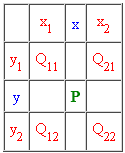Linear Interpolation Equation Calculator
Engineering - Interpolator Formula
To interpolate the y2 value:
x1, x3, y1 and y3 need to be entered/copied from the table.
x2 defines the point to perform the interpolation.
y2 is the interpolated value and solution.
| x1 | y1 |
| x2 | y2 |
| x3 | y3 |
Problem:
Solve for y2
Enter Inputs:
Can you share this page? Because, it could help others.
Solution:
Change Equation or Formulas:
Tap or click to solve for a different unknown or equation
 | linear interpolation single interpolator |
 | bilinear interpolation double interpolator |
What is linear interpolation?
Linear interpolation is a mathematical technique used to estimate an unknown value between two known data points on a straight line, assuming a constant rate of change between the points and that the function connecting them is linear.
Curve fitting, on the other hand, is a broader process of constructing a curve, or mathematical function, that best fits a series of data points. For example, linear interpolation can be considered a simple form of curve fitting where the curve is a straight line.
Why it is essential?
Linear interpolation and curve fitting are essential because they provide efficient ways to estimate values within a data set when exact data is unavailable, analyze data trends, and create graphical representations of data. These techniques are critical for approximation, data analysis, and visualization.
Linear interpolation equation
The linear interpolation equation is given by:
y = y1 + (x - x1) * ((y2 - y1) / (x2 - x1))
where (x1, y1) and (x2, y2) are the known data points, x is the unknown point's x-value, and y is the unknown point's y-value.
How to solve:
To solve for y using linear interpolation, follow these steps:
- Identify the two known data points, (x1, y1) and (x2, y2), surrounding the x-value for which you want to estimate the y-value.
- Substitute the known values into the linear interpolation equation.
- Solve for y.
Common mistakes:
- Extrapolating beyond the known data points can lead to inaccurate estimates.
- Using linear interpolation for non-linear data sets results in poor approximations.
- Not verifying the assumptions of a constant rate of change and linearity.
- Relying only on interpolation when more accurate methods or data are available.
- Misinterpreting the results, such as assuming the interpolated value equals the exact value.
- Sensitivity to outliers and extreme values in the data set.
Areas of use:
- Computer graphics and image processing
- Finance (e.g., interest rate calculations)
- Engineering (e.g., temperature and pressure estimations)
- Geographical Information Systems (GIS) and mapping
- Medical imaging
- Video game development
- Weather forecasting
- Audio signal processing
- Computer-aided design (CAD)
- Data science and analytics
Other types of interpolation:
- Polynomial interpolation
- Spline interpolation (e.g., cubic and B-spline)
- Hermite interpolation
- Rational interpolation
- Nearest-neighbor interpolation
Online Web Apps, Rich Internet Application, Technical Tools, Specifications, How to Guides, Training, Applications, Examples, Tutorials, Reviews, Answers, Test Review Resources, Analysis, Homework Solutions, Worksheets, Help, Data and Information for Engineers, Technicians, Teachers, Tutors, Researchers, K-12 Education, College and High School Students, Science Fair Projects and Scientists
By Jimmy Raymond
![]()
Contact: [email protected]
Privacy Policy, Disclaimer and Terms
Copyright 2002-2015